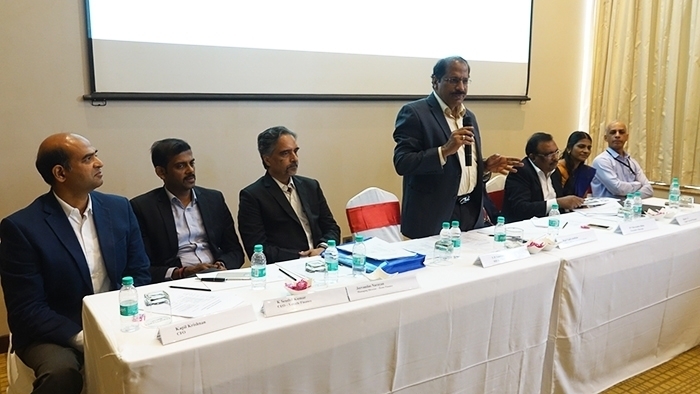V.P. Nandakumar, MD & CEO.
In recent months, there’s been a spate of media articles focussed on the success enjoyed by the leading players in the gold loan segment (incidentally, one of India’s fastest growing businesses), and how more and more people are shedding age-old taboos to borrow money against their gold jewellery. While this traditional business of lending money against gold was professionalized and scaled-up in recent years by Kerala-based NBFCs, all the major national banks have now jumped into the fray with enthusiasm. Moreover, the media attention is not restricted to India alone. Both the New York Times (“Out from India’s alleys, gold loans gain respect,” September 28, 2009) and the Washington Post (“In India, gold loans gain popularity as precious metal's prices soar,” January 12, 2010) recently carried stories about the growing popularity of gold loans in India.
It is therefore an apt moment to acquaint the reader with an insider’s perspective on why gold loans matter and why they hold so much promise for our country’s future.
Gold and domestic savings
In India the savings habits of the poor and lower classes differ significantly from the richer sections. While the rich invest their savings across many different kinds of assets, the poor continue to invest their savings mainly in gold. In fact, in rural areas, this is often a necessity because of lack of access to banks. Also, there are strong cultural factors at work in India which make gold not only a desirable but also a necessary asset to hold. Gold is traditionally a store of value, protecting our savings from inflationary devaluation. It also serves important ceremonial purposes, such as in a wedding celebration where gold is always the preferred gift. With increasing prosperity and sophistication, the relative importance of gold to the well-off may have declined, but among the poor it continues to rule.
The debt-trap
People in a rural, agrarian society will necessarily face the problem of fluctuating or unsteady incomes. The bulk of their earnings come in the two harvest seasons and the rest of the year can be difficult. It is no surprise that they frequently resort to borrowing money. Quite often, this involves a trip to the local money lender. The money lender is willing to oblige but the interest rates are sky-high which makes repayment a big concern. Loans go into a cycle of defaults and rollovers at ever higher rates of interest and, occasionally, the money lender ends up with the title to the property of the borrowers.
This is the classic debt-trap and a root cause of so much distress among the rural poor.
The many advantages of gold loans
If only people would fall back on their savings in the form of gold, and borrow money at reasonable rates of interest against the pledge of their gold ornaments, the debt-trap can be curbed to a large extent. Yet it does not happen because we are all emotionally attached to our gold jewellery and, even in these more permissive times, there is a stigma attached to pledging gold to borrow money. In fact, it is considered a sign of desperation so that when people borrow against gold, they don’t want their neighbours to know of it. And so, the reality is that rather than use their gold to raise money, their instinctive preference is to go to a moneylender and borrow at exorbitant rates.
In addition to his responsibilities in business, some of the other positions of leadership currently held by him include:
-
Avoids debt trap: A gold loan is settled either by repayment or, in case of default, by sale of the pledged security. The cycle of non-payment and rollovers of the loan at escalating rates of interest does not happen. In the worst case the borrower may lose his gold but there is no debt trap.
-
Simple procedures, fast disbursal: The formalities in availing gold loans are minimal and procedures are simple. In practice, the entire process should hardly take fifteen to twenty minutes. This makes gold loans ideal for the micro-finance segment where the loan amounts are small and where there is no point in testing the borrower’s patience with elaborate procedure.
-
No depreciation of underlying asset: Unlike other secured loans, the underlying asset in a gold loan is not subject to depreciation. At the same time, unlike land, it is a liquid asset and the transaction costs involved when enforcing the security are minimal. Thanks to this, the lender always enjoys a degree of comfort not available in other loans, and he does not have to go chasing after the borrower for timely repayments of instalments or EMIs. As for a borrower facing temporary difficulties, the only compulsion is to keep on servicing the interest component, till his situation permits repayment.
-
In practice, without recourse: Gold loans are effectively given out on a “without recourse” basis. Although the fine print of the loan agreement incorporates the right of recourse to the other assets of the borrower, in practice, this is almost never enforced. Defaults are settled by sale of the pledged gold and losses (if any) are written off. There are no recovery agents to go chasing after the borrower and his other properties with threats of legal action, court orders etc. In contrast, in a typical “secured” loan from a bank, in addition to the primary security, you need to put up collateral and bring along a Guarantor who also gets hauled into court in case of default.
-
No questions asked: People often borrow money on account of social compulsions which cannot be avoided in our cultural context; occasions like weddings, festivals, religious and social obligations etc. In this context, there is no denying that India’s banking sector continues to carry a hangover from the days of credit rationing that bank lending must always be for “productive” purposes. On the other hand, gold loans recognise that someone urgently in need of money cannot instead be made to settle for a lecture on wasteful consumption. Money is advanced solely on the criterion of the value of gold pledged and questions about the purpose of the loan would only be to confirm that anti-social or wildly speculative activities are not involved.
-
Suited for the unorganised sector: Gold loans are ideal for those employed in the informal or unorganised sector and lacking documents to prove their incomes. This is a segment conventional banks generally avoid because their appraisal and credit scoring is based on formal documentation. Incidentally, more than 90 percent of India’s workforce is employed in the unorganised sector.
-
Moral pressure against default: The recent success of the micro-finance sector has brought attention to the advantage of the group approach when lending to the poor. The loan is extended to individuals in a group and a default by any one member leads to the entire group being denied subsequent loans. Therefore, there is collective moral pressure on each member from the rest of the group to repay in time.
Something like this is at work in a gold loan too. There is no group approach but the market practice that gold loans are generally extended against household used jewellery has a similar impact. The fact is, borrowers and their families are emotionally attached to their family jewellery. Very often, it would have been acquired during important occasions like a marriage or the birth of a child etc. Occasions of wilful default, particularly with intention to capitalise on fluctuations in gold prices, are few and far between.
It therefore stands to reason that banks and financial institutions that choose to scale-up their gold loan portfolios would be able to do so with minimum risks. And, from a regulator’s perspective, gold loans can actually serve to minimise systemic risks.
-
Gains for the wider economy: India has the world’s largest stock of privately held gold with informed estimates ranging from 15,000 to 20,000 tonnes of gold. When this gold is kept idle in our lockers and vaults, it is a drag on the Indian economy: it has the effect of keeping billions of dollars in savings (at a conservative price of $1,000 /oz., it amounts to about $480 to $ 650 billion) out of the financial system. This is a huge sum that otherwise could have been lent out to industries and for building infrastructure. When people borrow against gold (technically called “monetization”), the impact is to set in motion a whole new chain of economic activity boosting demand and consumption expenditure in the economy.
The road ahead
There is now increasing recognition that economic and social policies need to be rooted in reality, not in any visions of an ideal world. Today, the ground realities are that significant sections of the rural poor continue to lack access to banks, either to park their savings in, or as a fallback for loans in times of need. Also, given the country’s atypical cultural context, gold continues to play an important part in our lives, reflected in the fact that India is consistently the world’s largest consumer of gold. Under these circumstances, the organised gold loan segment is potentially a vehicle for social transformation. Considering that 65 percent of our massive private stock of gold is held by rural households, and that 75 percent of the gold loan market continues to be with the unorganised sector (local moneylenders and pawnbrokers), this is a market with tremendous potential for growth.
At the same time, there is an urgent need for the government and the regulators to recognise the professionalism and transparency that the organised sector brings to this field and encourage its growth. We need a radical shift in the regulatory approach, from one of tolerance with a multiplicity of hurdles, to that of facilitation and active promotion. A useful beginning can be made by not treating this sector on a par with local moneylenders and pawnbrokers. And, it will help if gold loans are not clubbed with other NBFC lending when prescribing regulatory capital.
The distress faced by India’s farmers in recent years highlights the need to move on multiple fronts in extending timely credit to the rural masses. Gold loans must be made a part of this process.
Note: An edited version of this article was published in the op-ed page of The Economic Times dated July 29, 2010 under the title “Gold Loans aid financial inclusion”.
http://economictimes.indiatimes.com/opinion/policy/Gold-loans-aid-financial-inclusion/articleshow/6230807.cms





